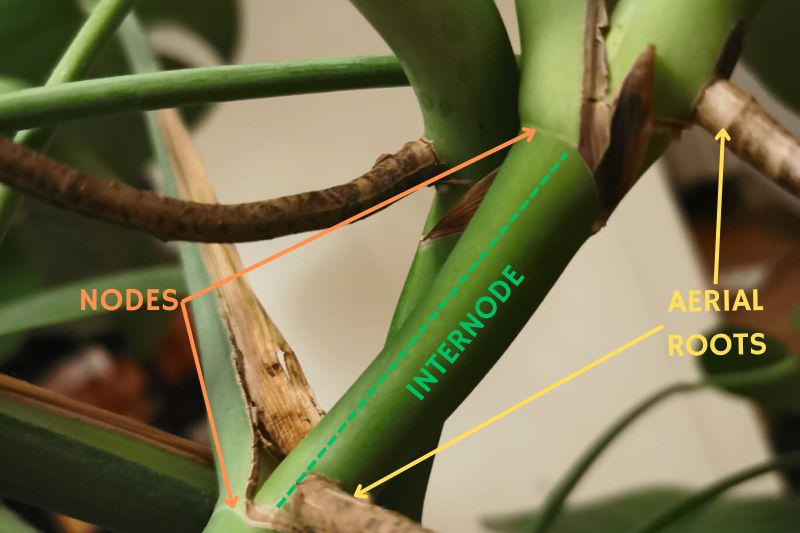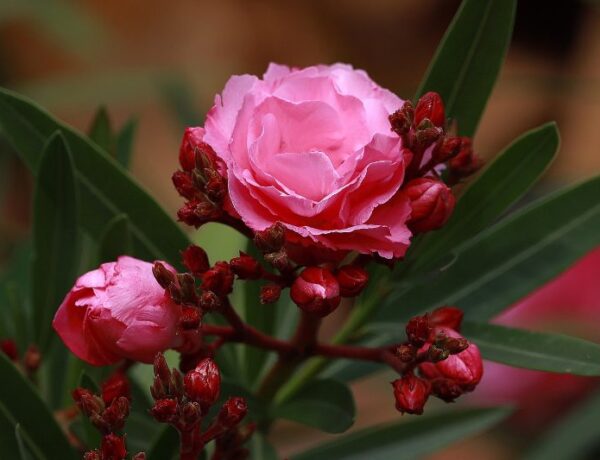Ever noticed those funny bumps or dangling bits on your beloved Monstera plant? They’re not there just for show—each one plays a critical role in helping your plant grow big and strong.
But what’s the difference between a node and an aerial root? And how can you take care of them to help your Monstera thrive? By the end of this, you’ll understand the differences between those two, as well as their role in growing an propagating your plant!
Table of Contents
The Stems of Monstera Plants
Before we delve into the details about nodes and aerial roots, let’s clarify what stems are. Stems are part of the shoot system of a plant, and they may range in length, depending on the plant type. They are usually above ground, but some plants, like potatoes, also have underground stems. They can be herbaceous (soft) or woody and have the main function of providing support to the plant, holding leaves, flowers, and buds.
Stems are characterized by the presence of nodes and internodes. Nodes are points of attachment for leaves, aerial roots, and flowers, while the internode is the region between two nodes. The petiole is the stalk connecting the leaf to the stem, and an axillary bud, which can give rise to a branch or a flower, is usually found in the area between the base of a leaf and the stem.

Monstera Nodes: The Stem Powerhouses
Nodes are the points from which leaves, and sometimes roots, grow. If you look closely, you’ll find that every leaf on your Monstera plant emerges from a node. Even when the leaf falls off, the node remains on the stem as a noticeable bump or ridge. Sometimes, nodes may also produce aerial roots.
If you’re planning to propagate your Monstera, you’ll need a piece of the stem that includes at least one node, as this is the part of the plant that can generate new growth. Aerial roots are not strictly necessary for propagation, although if they are present, they can help the new plant establish more quickly once potted.
Monstera Aerial Roots: The Multitasking Saviors
These are roots that grow out of the stem, often near a node but not always. They are brownish, stick-like structures that emerge from the stem and reach out into the air, hence the name “aerial”. In the wild, Monstera plants use these aerial roots to climb up trees or latch onto structures for support. Additionally, they absorb moisture and nutrients from the atmosphere.
Differences Between Monstera Nodes and Aerial Roots
While nodes and aerial roots are both integral to the Monstera plant, they differ in several ways:
1. Appearance
Nodes appear as slightly swollen or bumpy sections along the stem of the plant. If a leaf is present, the node is where the petiole (leaf stem) connects to the main stem. If the leaf has fallen off, the node is typically a noticeable ridge or ring on the stem.
Aerial roots appear as brown, stick-like projections that emerge from the stem. They can vary in length and thickness, often appearing wiry or spaghetti-like.
2. Growth
Nodes are present wherever a leaf grows out from the stem. The node remains after the leaf has fallen off.
Aerial roots grow from the plant stem, often near nodes. They tend to grow downward, reaching towards the soil.
3. Location
Nodes form directly on the stem, while aerial roots typically grow out of the stem near nodes but can sometimes grow out from nodes directly.
4. Function
Nodes are critical for plant growth and development as they are points of leaf and sometimes root growth. In many plant species, including Monstera, nodes contain meristematic cells, which are capable of division and growth into various types of plant cells. This enables the development of new stems, leaves, and sometimes roots from these points.
In their natural habitat, Monstera plants use these aerial roots to anchor themselves onto trees or other structures for support as they grow. When growing indoors, aerial roots can be left to grow freely, or they can be directed into the soil to take up nutrients and water, although this isn’t necessary for the plant’s health.
5. Care
Both nodes and aerial roots do not require special care.
6. Propagation
During propagation, nodes are essential for new growth, while aerial roots can quickly root into soil or water, nourishing the new plant.
wrapping it up
So there you have it – an in-depth look at Monstera nodes and aerial roots. Both are vital for the Monstera plant’s survival and growth.
By understanding these aspects, you can provide better care for your plant, ensuring its healthy growth and longevity. So, continue enjoying your Monstera, and remember – the more you learn, the greener your thumb becomes!






No Comments